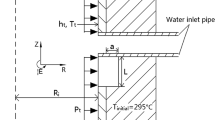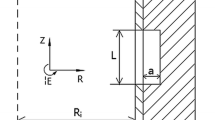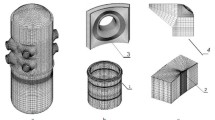The paper addresses some aspects of inclusion of loading history in the fracture strength analysis of reactor pressure vessels under thermal shock conditions. The strength assessment of a reactor pressure vessel and its lifetime extension are shown to essentially depend on reliability of results of elastic-plastic modeling of stress-strain kinetics and determination of design values of the fracture mechanics parameters. The present findings of the finite-element analysis demonstrate that the loading history must be taken into account in the determination of the temperature dependence of stress intensity factor for a postulated specified crack. It is shown that, in the fracture toughness analysis of a reactor pressure vessel, the temperature dependence of the stress intensity factor has to be derived from the results of the analysis of kinetics and mode of loading of metal at the crack tip under thermal shock conditions. For construction of the above dependence, we proposed approach, which accounts for the active loading and unloading processes occurring in the metal in the crack front vicinity. Incorporation of the loading history into the analysis of the temperature dependence of the stress intensity factor using the proposed approach forcan permit revealing some additional margin of strength during the substantiation of lifetime extension for a reactor pressure vessel under thermal shock conditions.
Similar content being viewed by others
Avoid common mistakes on your manuscript.
Introduction. Assurance of the reactor pressure vessel integrity under any loading conditions, including emergency situations, is one of the crucial prerequisites for safe operation of nuclear power plant (NPP) units and extension of their lifetime. A reactor pressure vessel is the most critical element of a reactor facility and its safe operation life actually dictates the NPP unit lifetime. For the reactor operating modes caused by emergency situations, it is the brittle fracture resistance which is taken as the main criterion for strength and integrity of the reactor pressure vessel (RPV).
The RPV integrity assessment and substantiation of the RPV lifetime extension essentially depend on reliability of results of computational modeling of stress-strain kinetics and determination of design values of the fracture mechanics parameters by the calculation output. The most important features of the fracture strength design analysis of RPV are considered to include the allowance of elastic-plastic deformation of metal in the vicinity of a postulated specified crack front and the history of thermomechanical loading.
We have not aimed to fully cover all the issues pertaining to methodological aspects of inclusion of the deformation loading history in analytical substantiation of RPV strength under thermal shock conditions. This paper provides some findings which, in our opinion, have not received adequate attention in the publications dedicated to finite-element calculations and general methodological approaches to the fracture strength assessment of reactor pressure vessels under thermal shock conditions. The calculations were conducted within framework of the the main regulations and guidelines of the respective references [1–4].
Results of Elastic-Plastic Analysis. First and foremost, to achieve a reliable modeling reasonably reflecting physical processes, one should ensure accuracy and convergence of the finite-element solution of the problem, which greatly depends on regularity and density of the finite-element mesh to be used. For solving an elastic-plastic problem, a fairly fine partitioning in the vicinity of a crack tip is required in order to determine stable calculated values of local fracture parameters, especially at the load relief stage. The experience of solving practical problems shows that in modeling emergency loading conditions for RPV the mesh size near the specified crack front can be about dozens of microns and smaller.
One of the important features revealed in such elastic-plastic solution is the presence of a drop, a so-called “descending branch” (DB), of calculated values of the stress intensity factor (SIF) at the end of the process of its variation vs. temperature during the RPV thermal shock. It is due to a local compressive-stress zone arising in unloading of metal ahead of the crack tip [5]. It has been found out that the use of insufficiently fine finite-element partitioning in the vicinity of a crack tip in the RPV analytical models with a built-in postulated crack gives no way of revealing any unloading zones; this distorts the true temperature dependence of SIF as obtained by means of sufficiently dense meshes that provide convergence of numerical results. Note that the presence of such a descending branch at the end of the RPV cooling mode is quite an important factor in the assessment of the RPV lifetime for it permits recognizing some additional margin of strength during the substantiation of lifetime extension.
Figure 1 depicts the results of three-dimensional elastic-plastic calculations with different mesh sizes in modeling typical emergency cooldown conditions; the FE model of RPV of WWER-1000 reactor was set to contain an under-the-cladding circumferential semielliptical 15-mm-deep crack (with the ratio of semi-axes being 0.3) located in the metal of Weld No. 4. The postulated crack dimensions and shape comply with those implied by [3]. Based on the results of calculations, we derived a temperature dependence of SIF for the deepest point of the crack front with variation of mesh size in the vicinity of the crack tip. When performing the calculations we used four variants of the mesh size: 275 × 290, 55 × 70, 11 × 24, and 2 × 5 μm, where the first numerals correspond to the value of the uniform mesh spacing in the meridian plane, while the second numerals represent the spacing along the crack front.
The curves shown in Fig. 1 show that for the active loading stages including a section with the maximum SIF value there is only an insignificant difference in the temperature dependencies of SIF, which were obtained with sparse and dense FE meshes. The greatest discrepancy in the results of the elastic-plastic calculation is observed on the descending branch of the SIF-vs.-temperature curve, which is attributed to the value of the mesh spacing in modeling of unloading of metal ahead of the crack front tip at the end of the cooldown mode.
One more important factor that has an influence on the determination of the temperature dependence of SIF is the inclusion of deformation loading history in thermal shock [6, 7]. It has been found that if the calculation is performed with no allowance for the elastic-plastic deformation history, e.g., in a linear elastic problem or in the case of using equations of the deformation plasticity theory, the resultant temperature dependence of SIF has no segment of a sharp decrease of calculated SIF values at the end of the cooldown mode, and the absence of the descending branch is noted not only for sparse FE meshes but also for fairly dense ones in the vicinity of the postulated crack front.
Figure 2 provides calculation data on the influence of inclusion of the elastic-plastic deformation history on the determination of the temperature dependence of SIF during the emergency cooldown of RPV. We considered three options of solving the problem: (i) the elastic-plastic calculation including the deformation loading history, which is based on the use of equations of the flow theory; (ii) the elastic-plastic calculation by means of equations of the deformation plasticity theory; (iii) the linear elastic calculation with no allowance for the strain hardening of metal.
In the elastic-plastic modeling, the calculation of stresses and strains for a current loading state was carried out with inclusion of fields of residual stresses and strains as obtained for the previous loading stage. The calculation based on the deformation plasticity theory and the linear elastic calculation were performed with no allowance for the deformation loading history, i.e., each stage of the loading process was calculated on condition that the RPV contained no initial stresses and strains.
The SIF-vs.-temperature curves (Fig. 2) plotted by the above-mentioned calculations enable us to infer the following. First of all, the linear elastic calculation yields lower SIF values in comparison to the elastic-plastic modeling with the loading history, i.e., the use of linear fracture mechanics results in a non-conservative assessment of fracture strength and thus in an overestimation of allowed loads. In the elastic-plastic calculation the maximum SIF values are approximately 26 to 28% higher than those in the linear elastic calculation. Also, the application of the deformation plasticity theory to the fracture strength analysis of RPV under thermal shock conditions and the linear elastic calculation give no way of revealing a local unloading zone in metal ahead of the crack front and thus arriving at a descending branch at the end of the emergency cooldown mode even if fairly dense FE meshes are used in the vicinity of the crack front.
Thus, the presence of a descending branch at the final stage of the SIF variation vs. temperature is due to the influence of the following factors on the calculated results: (i) the density of finite-element partitioning in the vicinity of the postulated crack front and (ii) the inclusion of the elastic-plastic deformation history in modeling the RPV emergency cooldown conditions.
Considering that a descending branch of the temperature dependence of SIF can be obtained only in the elastic-plastic analysis using fairly dense FE meshes, the practical implementation of such calculation in modeling the reactor emergency cooldown mode requires significant computational and time expenditures. Also, it should be noted that the use of the invariant, i.e., independent of the integration path, Cherepanov–Rice contour J-integral [8] for the SIF computation and the calculation of the energy J-integral by the method of volume equivalent integration [9, 10] will be fully correct only if the body is elastic or obeys the equations of the deformation plasticity theory.
Thus, there is a need to elaborate a more sophisticated and cost-effective approach to inclusion of the loading history in the fracture strength analysis of RPV under thermal shock conditions. This makes it possible to allow for the metal unloading effect in the determination of the temperature dependence of SIF to be plotted by the results of the elastic-plastic calculation using FE meshes with a fairly moderate size in the vicinity of a postulated crack front.
Noteworthy is that, in the fracture strength analysis of reactor pressure vessels under thermal shock conditions, the inclusion of loading history should not be limited to an incremental solution of an elastic-plastic boundary-value problem, but also involve derivation of the temperature dependence of SIF for a postulated crack based on the analysis of kinetics and mode of loading of metal at the crack tip under thermal shock conditions. The issue of a physical model of the crack-tip material behavior is not addressed here; we consider merely the appropriateness of using the proposed approach to plotting the temperature dependence of SIF with allowance for a possible formation of local metal unloading zones ahead of the crack tip.
Inclusion of Loading History in the Analysis of the Temperature Dependence of SIF. Provided the loading of a RPV with a postulated crack is treated as a process, the conditions for a virtual crack growth can be stated as follows. Assume that the active loading conditions for a body with a crack are realized at the crack tip if the calculated amount of energy G(t) needed for the separation displacement of the upper and lower crack faces in a zone of adhesion forces is positive and does not decrease in the process of loading, i.e.,
where t is time or any other parameter that represents the load variation. For an arbitrary loading history the quantity G(t) is not a steadily increasing function of the loading parameter t and depends on the kinetics and mode of the stress-strain state in the close vicinity ahead of the crack tip. In the active loading process the calculated value of G(t) increases, while during the unloading it decreases.
If we use the function K 2 (t) ~G (t), where K(t) is the stress intensity factor, then in view of (1) we have the following conditions of active loading:
In the analytical modeling of the RPV stress-strain state kinetics the loading process is usually split into individual loading stages [t n-1, t n ]. Then, in view of the integration of the second inequation in (2) within one stage we have
If the conditions (3) are used for the calculation of the temperature dependence of SIF, it is unnecessary to detail the curve segments with a descending branch because the active loading conditions are not fulfilled for these segments. For the determination of the maximum allowable critical brittleness temperature for the RPV metal, it suffices to separate out only those segments of the temperature dependence of SIF for which the active loading conditions (3) are fulfilled.
To assess how significant the effect of inclusion of loading history can be, we will provide here the results of determination (by the proposed approach) of the maximum allowable critical brittleness temperature for RPV, T ka , using the temperature dependence of fracture toughness K 1c (T) as specified in the applicable guidelines [3]:
where T k is the critical brittleness temperature.
Figures 3–5 give graphical data for the determination of the maximum allowable critical brittleness temperature for RPV metal T ka by the tangential point approach, thermal pressurization method, and by the proposed approach with inclusion of the temperature dependence of SIF as derived by the results of elastic-plastic calculations using sparse and dense FE meshes. The time from the onset of emergency cooldown of RPV was taken as a loading parameter in inequation expressions (3) (Fig. 4).
Determination of the maximum allowed critical brittleness temperature for RPV metal, based on the thermal pressurization method and temperature dependence of SIF as derived using a sparse (□) and dense (○) FE meshes [(1) K 1c , T ka = 71°C; (2) K 1c , T ka = 87°C; dash line correspond to K 1= 0.9 K 1max].
Determination of the maximum allowed critical brittleness temperature for RPV metal, based on the proposed approach and temperature dependence of SIF as derived using a sparse (□) and dense (○) FE meshes [(1) K 1c , T ka = 86°C; (2) K 1c , T ka = 91°C; (3) sparse FE mesh (DB); (4) dense FE mesh (DB)].
According to the results provided, the use of the proposed approach that involves the inclusion of loading history in the analysis of the temperature dependence of SIF leads to a noticeably smaller conservatism in the analytical evaluation of the maximum allowable critical brittleness temperature T ka in comparison with the T ka assessment by the tangential point approach and thermal pressurization method [1–4].
In the case with a sparse FE mesh, the proposed approach provides a much better result of determination of T ka and brings the analytical assessment closer to the T ka value found by means of a dense FE mesh. The tangential point approach gives the following calculated values: T ka = 69°C for a sparse FE mesh and T ka = 85°C for a dense one. Using the thermal pressurization approach we have: T ka = 71°C for a sparse mesh and T ka = 87°C for a dense mesh. The results of the T ka determination by the proposed method are as follows: T ka = 86°C for a sparse mesh and T ka = 91°C for a dense one.
Thus, the inclusion of loading history in the analysis of the temperature dependence of SIF by the proposed approach makes it possible to obtain a less conservative assessment of the maximum allowable critical brittleness temperature T ka in comparison with the tangential point approach and thermal pressurization method, which are conventionally employed in international and local practice of the brittle fracture strength design of reactor pressure vessels [1–4]. This is quite a significant factor in the analysis of fracture strength of RPV under thermal shock conditions, for it can permit substantiating some additional strength and lifetime margins.
References
Unified Procedure for Lifetime Assessment of Components and Piping in WWER NPPs (VERLIFE), Version 2008.
Pressurized Thermal Shock in Nuclear Power Plants: Good Practices for Assessment, IAEA-TECDOC-1627, Vienna (2010).
RD ÉO 0606-2005. Calculation Procedure for Brittle Fracture Resistance Analysis of NPP WWER Reactor Pressure Vessels (MRKR-SKhR-2004) [in Russian], St. Petersburg–Moscow (2004).
V. V. Kharchenko, G. V. Stepanov, et al., MT-D.0.03.391-06. Procedure of Strength and Lifetime Assessment for WWER Reactor Pressure Vessels in Operation [in Russian], Kiev (2009).
V. V. Kharchenko, V. A. Piminov, A. Yu. Chirkov, et al., “Elastoplastic fracture resistance analysis of NPP primary circuit equipment elements,” Strength Mater., 45, No. 4, 397–405 (2013).
V. V. Kharchenko, A. Yu. Chirkov, S. V. Kobel’skii, et al., “The influence of thermomechanical loading history on the stress level in WWER NPP reactor pressure vessels under thermal shock,” Strength Mater., 42, No. 1, 17–24 (2010).
V. V. Kharchenko, O. Yu. Chirkov, S. V. Kobel’skyi, et al., “Further development of the methodology of fracture strength calculation of NPP equipment elements,” in: Strength of Materials and Theory of Structures [in Ukrainian], Collected Papers, Issue 94, KNUBA, Kyiv (2015), pp. 59–74.
G. P. Cherepanov, Brittle Fracture Mechanics [in Russian], Nauka, Moscow (1974).
H. G. deLorenzi, “On the energy release rate and the J-integral for 3-D crack configurations,” Int. J. Fracture, 19, No. 3, 183–193 (1982).
G. P. Nikishkov, “Computation of energy integral by the equivalent volume integration method,” in: S. N. Atluri (Ed.), Computational Methods in the Mechanics of Fracture [Russian translation], Mir, Moscow (1990), pp. 365–367.
Author information
Authors and Affiliations
Additional information
Translated from Problemy Prochnosti, No. 5, pp. 14 – 21, September – October, 2016.
Rights and permissions
About this article
Cite this article
Kharchenko, V.V., Chirkov, A.Y. Some Aspects of Inclusion of Loading History in the Fracture Strength Analysis of Reactor Pressure Vessels Under Thermal Shock Conditions. Strength Mater 48, 603–609 (2016). https://doi.org/10.1007/s11223-016-9803-y
Received:
Published:
Issue Date:
DOI: https://doi.org/10.1007/s11223-016-9803-y









